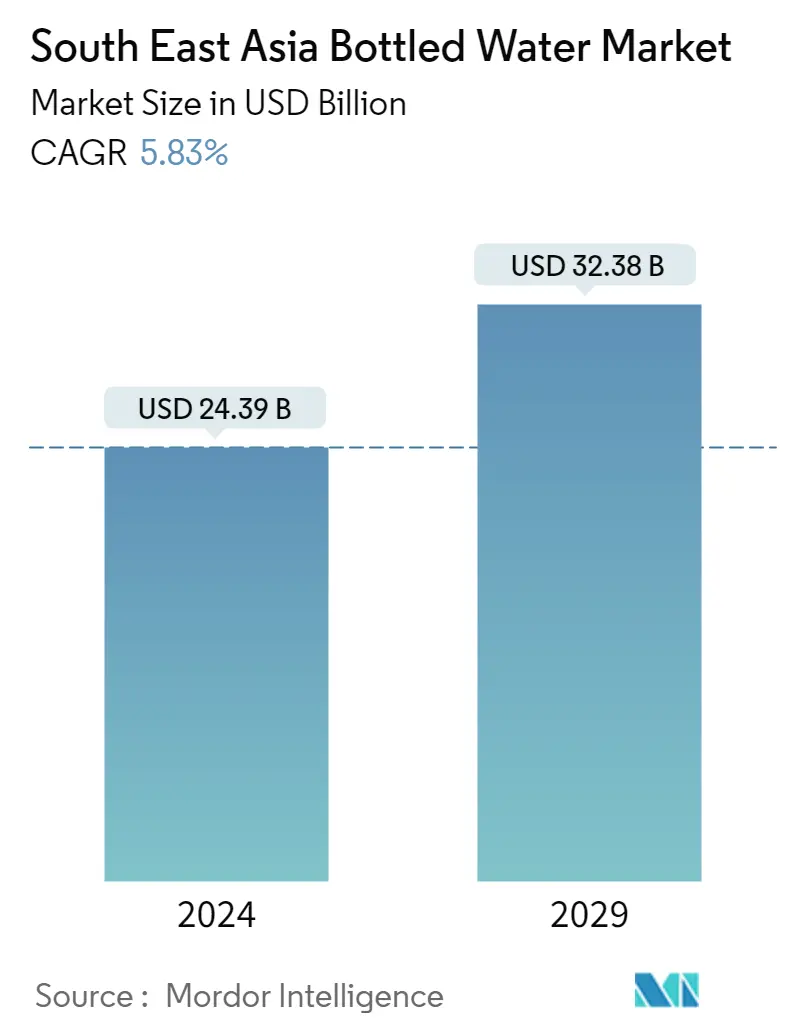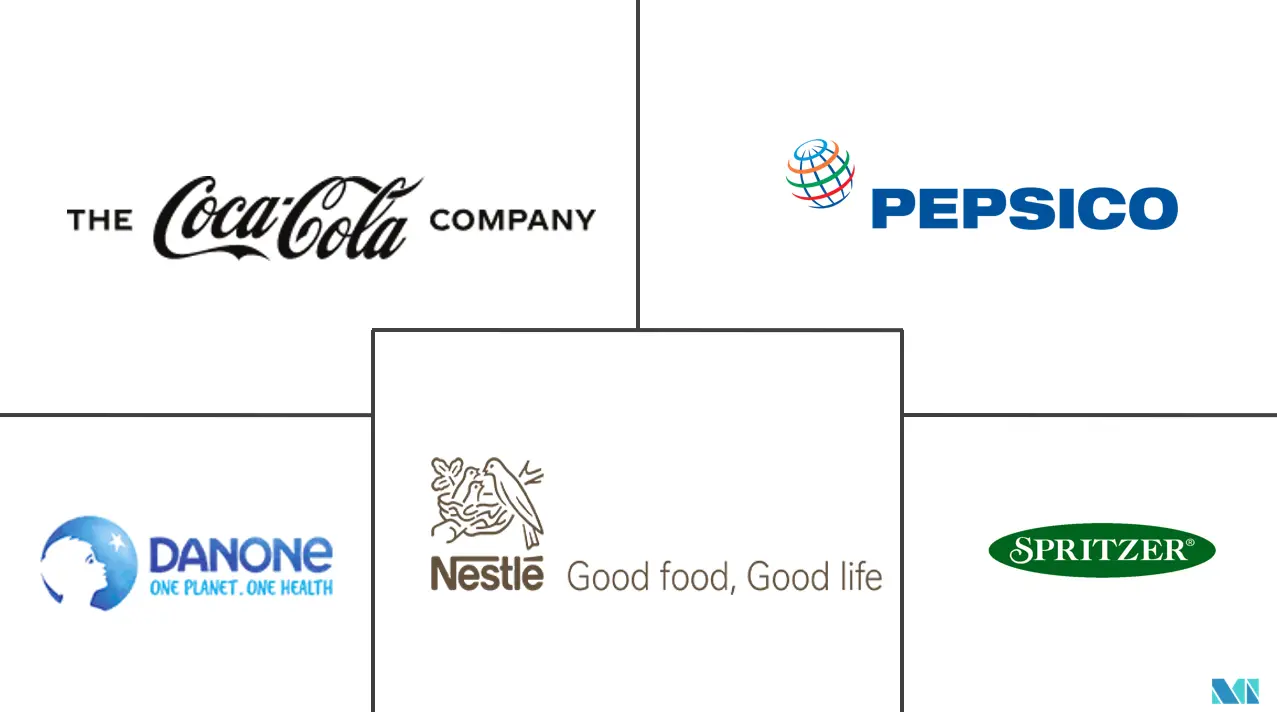Market Size of South East Asia Bottled Water Industry

| Study Period | 2019 - 2029 |
| Base Year For Estimation | 2023 |
| Market Size (2024) | USD 24.39 Billion |
| Market Size (2029) | USD 32.38 Billion |
| CAGR (2024 - 2029) | 5.83 % |
| Market Concentration | Low |
Major Players
*Disclaimer: Major Players sorted in no particular order |
Southeast Asia Bottled Water Market Analysis
The South East Asia Bottled Water Market size is estimated at USD 24.39 billion in 2024, and is expected to reach USD 32.38 billion by 2029, growing at a CAGR of 5.83% during the forecast period (2024-2029).
- Southeast Asia has abundant water sources. However, tap water has many contaminants and pollutants that impact the health of a wider population. For instance, according to a United Nations International Children's Emergency Fund (UNICEF) report published in February 2022, nearly 70% of the household-sourced drinking water in Indonesia was contaminated with fecal waste, which further facilitated the spread of diarrheal disease. As a result of increased contamination of tap water, the demand for bottled water has been growing consistently for the past several years.
- Countries such as Indonesia, Philippines, Thailand, and Malaysia in the Southeast Asian region are categorized under newly industrialized countries globally, which led to a rapid expansion of the bottled water industry in the region. Observing the difference in the quality of the product, consumers prefer global players over domestic players, resulting in the domestic players not gaining a higher market share.
- Over the long term, changing customer preferences and growing demand for clean and safe drinking water aid the growth of the bottled water market in Southeast Asia. Rising southeast Asian disposable income coupled with an increase in traveling and consumption of food outside of home across the region are a few other macro factors likely to fuel growth in the market over the forecast period.
Southeast Asia Bottled Water Industry Segmentation
Bottled water is packaged drinking water generally sold in plastic or glass bottles.
The Southeast Asia bottled water market report is segmented based on product type, which includes still water, carbonated water, and Functional/Fortified water. By distribution channel, the market is segmented into on-trade and off-trade. Furthermore, the off-trade channel is sub-segmented into supermarkets/hypermarkets, convenience/grocery stores, home and office delivery, and others. The study also analyzes regions such as Thailand, Malaysia, Singapore, Indonesia, Vietnam, Philippines.
The report offers the market size and forecasts for value (in USD million) for all the above segments.
| Product Type | |
| Still Water | |
| Carbonated Wtaer | |
| Functional/Fortified Water |
| Distribution Channel | ||||||
| On-Trade | ||||||
|
| Geography | |
| Thailand | |
| Malaysia | |
| Singapore | |
| Indonesia | |
| Vietnam | |
| Phillipines | |
| Rest of Southeast Asia |
South East Asia Bottled Water Market Size Summary
The Southeast Asia bottled water market is experiencing significant growth, driven by the increasing demand for clean and safe drinking water amid concerns over tap water contamination. Countries like Indonesia, the Philippines, Thailand, and Malaysia, classified as newly industrialized, are witnessing a rapid expansion in the bottled water sector. The preference for international brands over domestic ones, due to perceived quality differences, has further fueled this growth. Macroeconomic factors such as rising disposable incomes, increased travel, and dining out are also contributing to the market's expansion. The market is characterized by a fragmented landscape with key players like Danone, Coca-Cola, Nestle, and PepsiCo dominating various national markets.
The demand for bottled water is further bolstered by the growing awareness of health and wellness, alongside campaigns promoting healthy lifestyles. In Indonesia, the lack of access to clean water and the prevalence of waterborne diseases have led to a heightened reliance on bottled water for both drinking and cooking. This trend is supported by the introduction of innovative products, such as recyclable and label-free bottles, catering to the increasing consumer interest in sustainability. The market is also seeing a shift towards sparkling water, driven by health-conscious consumers seeking vitamin and mineral-fortified options. Despite the lack of significant product innovation, companies are focusing on new product launches, particularly in the flavored and functional water segments, to maintain their market dominance.
South East Asia Bottled Water Market Size - Table of Contents
-
1. MARKET DYNAMICS
-
1.1 Market Drivers
-
1.2 Market Restraints
-
1.3 Porter's Five Forces Analysis
-
1.3.1 Threat of New Entrants
-
1.3.2 Bargaining Power of Buyers/Consumers
-
1.3.3 Bargaining Power of Suppliers
-
1.3.4 Threat of Substitute Products
-
1.3.5 Intensity of Competitive Rivalry
-
-
-
2. MARKET SEGMENTATION
-
2.1 Product Type
-
2.1.1 Still Water
-
2.1.2 Carbonated Wtaer
-
2.1.3 Functional/Fortified Water
-
-
2.2 Distribution Channel
-
2.2.1 On-Trade
-
2.2.2 Off-Trade
-
2.2.2.1 Supermarkets/Hypermarkets
-
2.2.2.2 Convenience/Grocery Stores
-
2.2.2.3 Online Retail Stores
-
2.2.2.4 Other Off-Trade Channel
-
-
-
2.3 Geography
-
2.3.1 Thailand
-
2.3.2 Malaysia
-
2.3.3 Singapore
-
2.3.4 Indonesia
-
2.3.5 Vietnam
-
2.3.6 Phillipines
-
2.3.7 Rest of Southeast Asia
-
-
South East Asia Bottled Water Market Size FAQs
How big is the South East Asia Bottled Water Market?
The South East Asia Bottled Water Market size is expected to reach USD 24.39 billion in 2024 and grow at a CAGR of 5.83% to reach USD 32.38 billion by 2029.
What is the current South East Asia Bottled Water Market size?
In 2024, the South East Asia Bottled Water Market size is expected to reach USD 24.39 billion.

